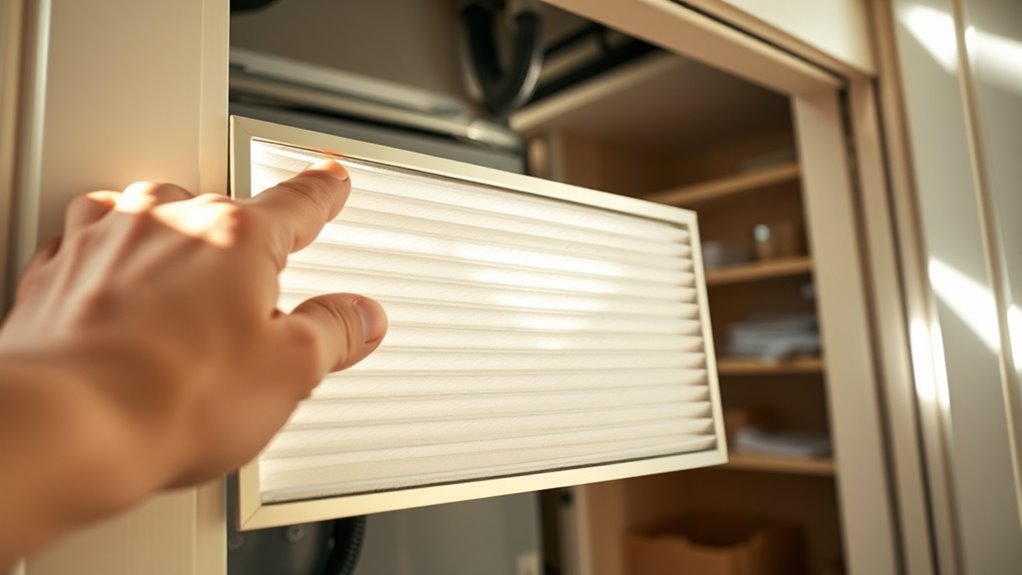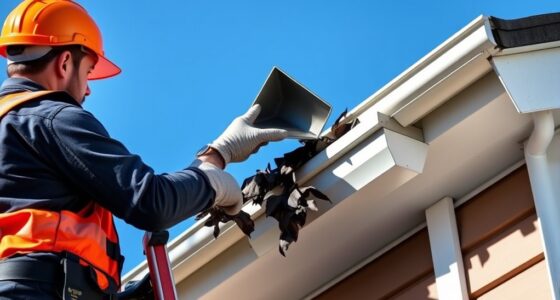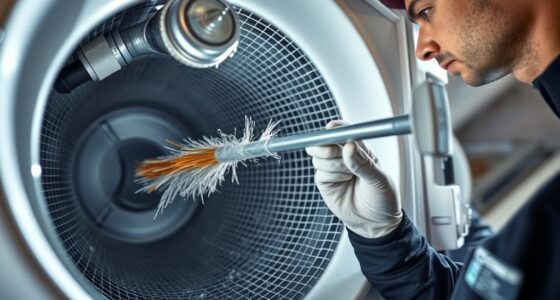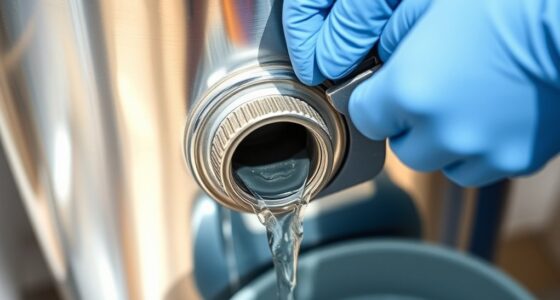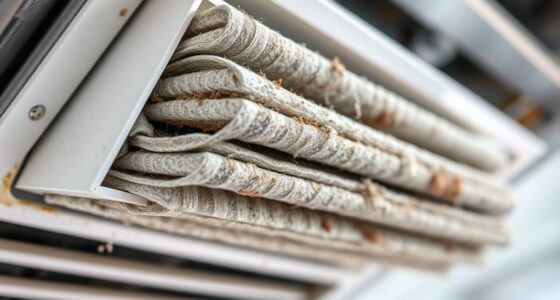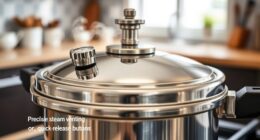The simple rule for changing your HVAC filter is to do it every 1 to 3 months. If you have pets, allergies, or live in a dusty environment, switch it closer to every month. For low-dust homes with pleated filters, up to 3 months may be acceptable. During busy heating or cooling seasons, check filters monthly to ensure they’re clean. Keep an eye on color and dirt levels — if you spot issues, it’s time for a change. If you continue, you’ll find more helpful tips to keep your system running smoothly.
Key Takeaways
- Replace your HVAC filter every 1 to 3 months for optimal system performance and air quality.
- Pet owners and allergy sufferers should change filters monthly to prevent buildup and maintain clean air.
- Use the simple rule: check filter condition monthly and replace when visibly dirty or clogged.
- During peak heating or cooling seasons, increase filter checks and replacements to maintain efficiency.
- Consider filter type and household conditions; high-efficiency filters may last longer, but regular inspection is key.
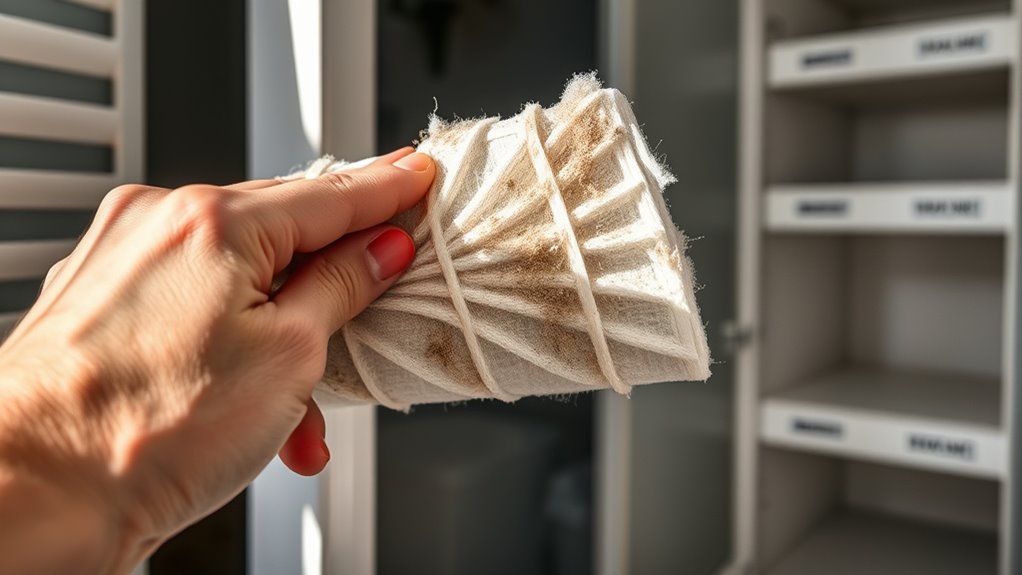
Have you ever wondered how often you should change your HVAC filter to keep your system running efficiently? The answer isn’t one-size-fits-all, but there’s a simple rule you can follow that makes it easy to remember. Generally, you should replace your filter every 1 to 3 months. This schedule helps ensure your system operates smoothly, your indoor air stays clean, and you avoid costly repairs down the line. The key is paying attention to a few factors that can influence how frequently you need to change the filter.
Replacing your HVAC filter every 1 to 3 months ensures smooth operation and cleaner indoor air.
If you live in a household with pets, especially if they shed a lot, you’ll want to change the filter closer to once a month. Pet hair and dander quickly clog filters and reduce airflow, forcing your system to work harder. Similarly, if someone in your home has allergies or respiratory issues, more frequent changes help maintain better indoor air quality. On the other hand, if you live in a relatively dust-free environment, you might stretch that schedule a little longer, perhaps up to three months.
The type of filter you use also impacts how often you should change it. Basic fiberglass filters tend to clog faster and need replacing more often, while high-efficiency pleated filters can last longer—sometimes up to three months—if your household isn’t too dusty or pet-heavy. Checking the manufacturer’s recommendations can give you a good starting point, but it’s smart to monitor the filter’s condition visually. If it looks dirty or clogged, it’s time to swap it out, regardless of the date.
Another factor to consider is the season. During peak heating or cooling months, your HVAC system runs more frequently, which means the filter works harder and gets dirty faster. During milder months, you might be able to extend the interval between changes. It’s a good habit to check your filter monthly, especially during busy seasons, to catch any buildup early.
Additionally, being aware of the color accuracy of your filter can help you determine when it’s time for a replacement, as discoloration often indicates dirt buildup and reduced filtration efficiency.
Frequently Asked Questions
How Do I Know if My HVAC Filter Needs Changing Sooner?
You’ll know your HVAC filter needs changing sooner if you notice reduced airflow, increased dust buildup, or your allergies worsen. Check the filter monthly—if it looks dirty or clogged before the recommended change date, swap it out earlier. A visibly dark or clogged filter indicates it’s time for a replacement. Regular inspections help you catch issues early, ensuring your system runs efficiently and maintains good indoor air quality.
Can I Use a Generic Filter Instead of the Recommended One?
You can use a generic filter, but be aware that about 85% of filters don’t meet efficiency standards. Using a lower-quality filter may save you money upfront, but it can reduce airflow and strain your system. Always check the MERV rating—aim for 8 to 13 for the most effective filtration. If the generic filter meets these specs, it’s fine; otherwise, stick with the recommended filter for better air quality and system longevity.
What Are the Signs of a Clogged or Dirty Filter?
You’ll notice reduced airflow, which makes your vents feel weak or blocked. If your heating or cooling seems less effective, that’s a sign. You might see more dust or debris around vents, or your allergy symptoms worsen. Unusual odors or increased energy bills also point to a dirty filter. Check your filter regularly, and replace it when it looks clogged or dirty to keep your HVAC system running efficiently.
How Often Should I Replace Filters in Different Seasons?
You should replace your HVAC filter every 1 to 3 months, depending on the season. During peak use in winter and summer, change it every month to guarantee ideal airflow and efficiency. In milder seasons like spring and fall, every two to three months is usually enough. If you have pets or allergies, consider changing filters more frequently. Regular replacements keep your system running smoothly and improve indoor air quality.
Is There a Special Filter for Allergy Sufferers?
Yes, allergy sufferers should use high-efficiency particulate air (HEPA) filters or filters with a MERV rating of 13 or higher. These filters trap small particles like pollen, pet dander, and dust mites more effectively than standard filters. Make sure to change these filters regularly, usually every 1-3 months, especially during peak allergy seasons, to maintain good indoor air quality and reduce allergy symptoms.
Conclusion
Changing your HVAC filter on time keeps your home’s air fresh and your system running smoothly. Imagine breathing in crisp, clean air every day, free of dust and allergens. When you stay ahead of filter changes, it’s like giving your home a gentle refresh—like opening a window to a breezy spring day. Keep that filter fresh, and enjoy the comfort of a healthy, inviting space where every breath feels just right.
